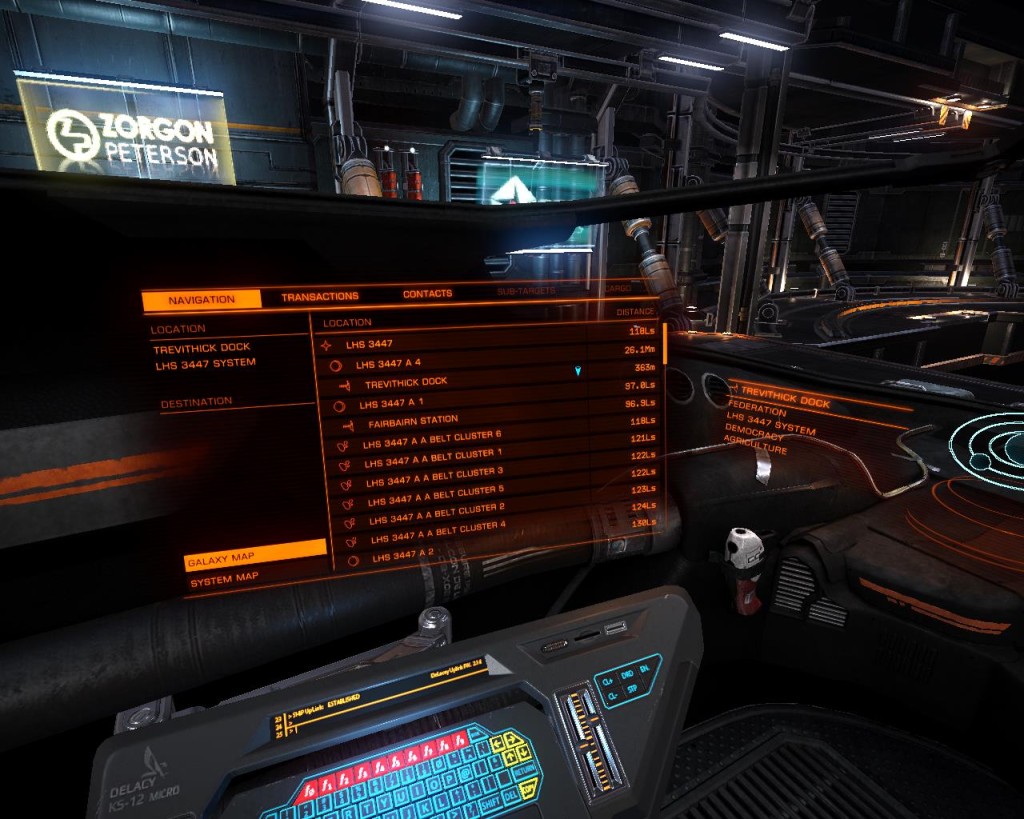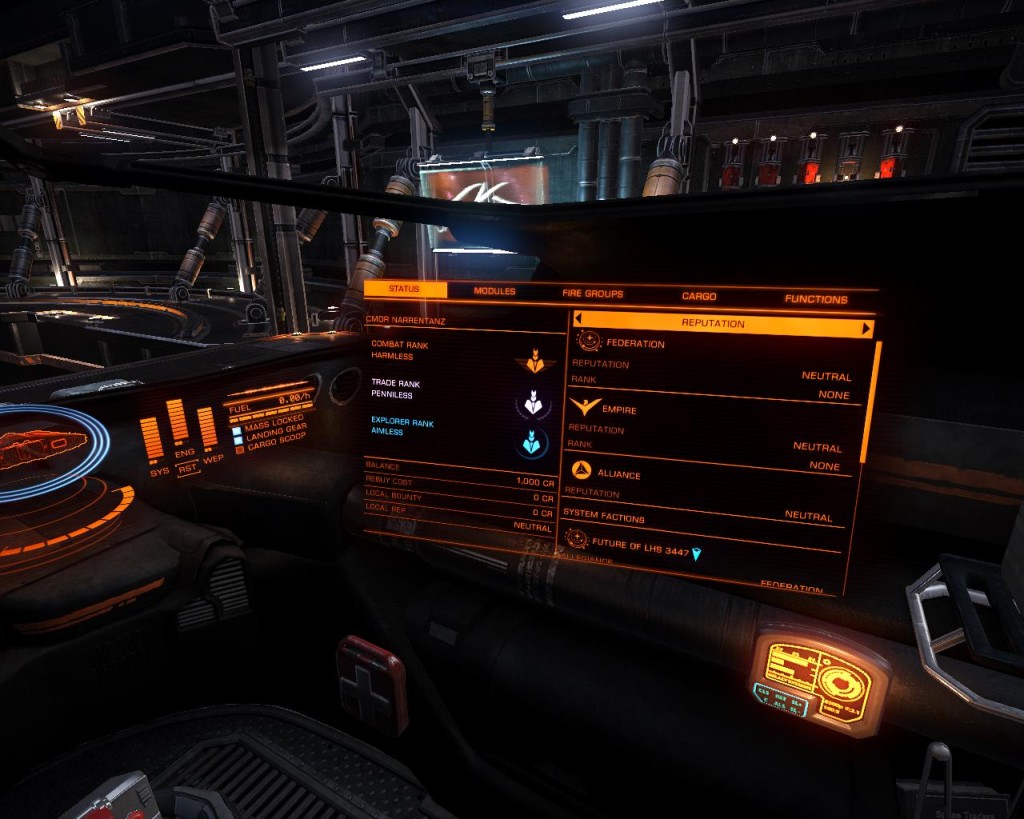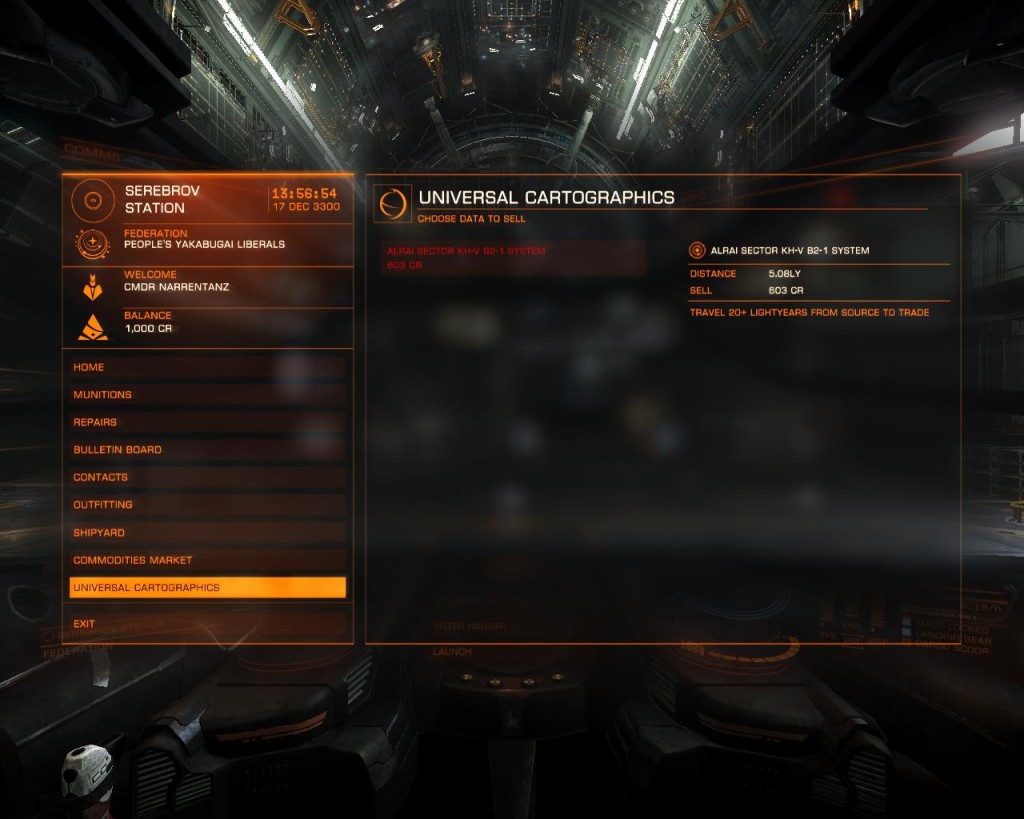In this very picture-heavy post with too many words in it I will give a basic overview of the UI, the things you can do and my first failing.
Spacegames traditionally tend to be pretty spreadsheet programs with an attached space combat simulator. The more agency the player is given, the worse it gets. Advanced industrialist gameplay in X is a complex thing, as the player has to manage factories, transporters and escorts.
But even single ship simulations tend to throw a metric shitload of information at the player, getting worse with the depth of the simulation. Elite has many, many solar systems for the player to visit, each with planets, stations and other ships, each with their own load of information. So let’s take a look at the spreadsheets used.
I’m at station and in a hangar, so these are indoor-shots.

Upper left: comms. Chat and ingame-messages by NPC. Things like “I’ll kill you” or “docking permission granted”.
Upper right: infos. When contacts appear or disappear in our area, we’re notified here. Same goes for everything regarding our ship, like the “landing gear deployed”-message in the screenshot.
Lower part, left to right: Target information and target representation. Currently set to the system I’m in, we see the “system”-icon, and currently docked we see the information of the station: name, allegiance, system and basic system infos. If we target a ship, the target representation also gives the orientation relative to the player ship, shield and hull status and damage indicators.
In the middle, currently overlayed by the docking menu, is the map.
Player ship status monitor, with shield and hull, energy distribution, fuel gauge and status indicator. The ship is mass locked if it’s too close to another mass, eg. a station. Being mass locked means that we cannot engage the hyperdrive. Landing gear is landing gear, and cargo scoop is the “get this thing into my cargo bay”-loot modus. Both slow us down.
Would we have the hardpoints deployed, we would have an additional HUD over our main window with ammunition/energy status and probably several other indicators, depending on equipment and deployment status.

Navigation-menu with all celestial objects in the sector and the adjacent sectors. Transactions lists accepted mission contracts. Contacts is the close-range overview with all ships in the vicinity. A bit strange is the fact that we can only open comms via the contacts-tab – this lead to me wondering if I’m going crazy as I could request docking at a station via the navigation-tab. Sub-targets for subsystems of bigger fishes, cargo to scan other people with a cargo-scanner. Right side is the “other people”-monitor.

The left side is the me-monitor.
Status with pilot ranks and wallet information, reputation (who likes us how little, globally and locally), granted permits, the obligatory player statistics (economics, combat, semilegal activities), finance and system status (how much influence which local group holds).
Modules show what we’ve currently installed, fire groups lets us group our guns and other equipment and cargo shows our cargo-hold.
Functions gives access to a variety of ship functions, the most important probably the faction setting with which we can set our IFF during conflicts.
Now let’s take a look at the services offered by starports:

Home contains information about our ship (hull integrity, fuel gauge, refuel, repair, restock) and the news, munitions and repairs are what is says on the tin, the bulletin board is where mission contracts are posted and contacts allows us to visit the pilots’s federation and the local security office, the combat bond contact and the black market. Because advertising a black market right on the city map is the best place to keep business going. The shipyard is where ships are sold – I’m sure no one saw that coming. Outfitting brings us into the hangar, where we can purchase new equipment and customize our ship. There’s a whole lot of equipment with different characteristics (mass, power use, thermal load…), each influencing the ship’s performance. I’ll talk about equipment and ships as I get it, as I’ve not much of an idea how this works yet.
The commodities market is the run of the mill trading area. Buy cheap, sell for a profit, rinse, repeat.
Universal Carthographics is the in-universe carthographic agency: they will buy the data we get by scanning stars and planets, provided we keep a certain distance between our place of sale and the scanned system.
The last thing I want to show is the in-flight UI:
Sub-c-flight with target marker on the left, superluminal space magic flight on the right. The target marker marks your target. If we would have targeted a ship, the marker would also show the orientation of the target.
Note the minimap, which was covered by the station menu before. On the right side of it is our speed indicator, on the right the heat indicator. Building up too much heat damages our ship – incidentally, we usually jump in a new system on a collision course with the local star, so “turning somewhere else” is rather important.
Also on the left side is our target compass, indicating the direction of our targeted object. Dot means we’re looking at our target, circle means we’re looking in the opposite direction. Took me a few minutes to notice that this thing has both…
During superluminal flight, the outer left panel shows us a) whether or not we’re aligned to our target, b) the distance and c) our relative speed (I guess). When the distance indicator is within the blue area we can disengage our hyperdrive and drop to subluminal speed, in a convenient distance to our target. As long as we’re slow enough, that is.
And now for my first misadventure.
I took the one available contract at my starting point to go and bring in three “rebel transmissions”. I plotted my course, jumped there and had no bloody idea what to do. In the end I guessed that the “unidentified signal source”-waypoint would be it, so I relocated and looked around. There was one contact with a bounty on his head, so I shot him down. Bad idea, as local security forces started blasting me out of the sky. I scrapped my savegame and started a new one, but that’s a story for another day.
In the meantime I’ve learned that a module exists which forces ships to drop their cargo, provided the shields are down. This… might have been the way to do this. Maybe.
This is a common problem of open world space games: you have an open world (and lots of it), but are provided no guidance whatsoever. Here, have fun, do something. Anything. The same problem can be seen in the X-series to a varying degree, it can be seen in EVE Online, in Freelancer once the player moved past the first story mission… while giving the player the highest degree of freedom possible is exactly the point of open world games, having no story arc (at least I haven’t found one in E:D yet) and no beacons telling you “this might be useful” is a big hurdle regarding accessibility.
And I have no great idea what to do against it.
See you next time.


